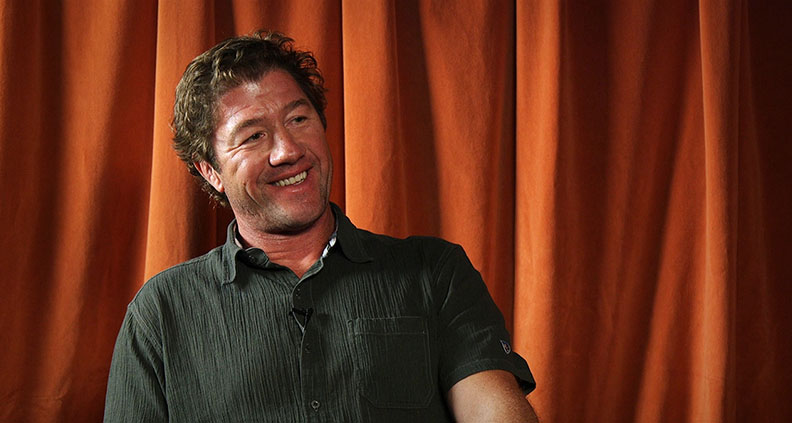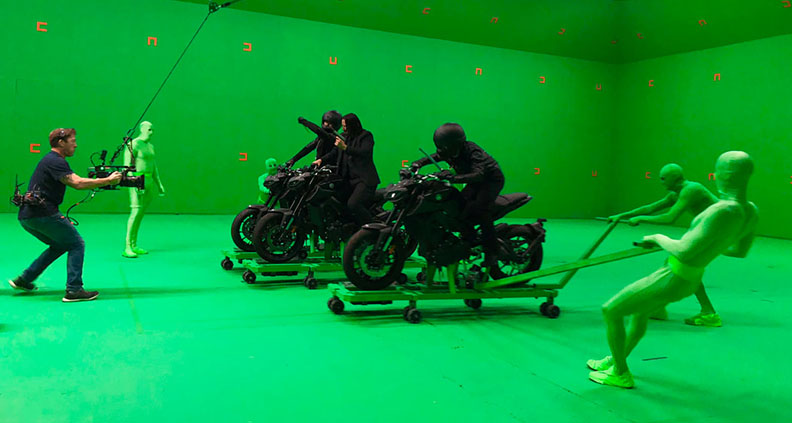BONUS: Stunt Coordinator Darrin Prescott Dissects ‘John Wick’s Best Action Scenes
Movies are a mosaic of moving parts. But we don’t always see which parts, or who’s moving them. In Detail Oriented, Su Fang Tham explores some of the more specialized areas — and career paths — related to film production.
***
Following the staggering $326.7M worldwide box office of last year’s John Wick: Chapter 3 – Parabellum, studio Lionsgate wasted no time in committing to both a fourth and fifth installment of the hit action franchise, with star Keanu Reeves once again slated to return as the titular puppy-loving, revenge-seeking assassin. COVID-19 restrictions permitting, Chapters 4 and 5 will reportedly be shot back-to-back when film production resumes next year.
Over three films, the Wick series has managed to enthrall fans with its unique amalgamation of pulp storytelling and videogame-esque stylized violence — neither of which would be possible without Wick’s expert action choreography, which in recent years has reinvented the genre.
Stunt Coordinator Darrin Prescott has been with the franchise from the very beginning, back when the original John Wick debuted as a $20 million indie in 2014. In Part Two of our two-part interview, we asked Prescott to take us through the design and execution of the series’ neon-drenched kinetic stunt sequences — from “car-fu” to “horse-fu” and everything in-between.
DARRIN PRESCOTT

How did the car chase sequence at the end of John Wick come about?
Prescott: It was just before the big showdown between John (Reeves) and Viggo (Michael Nyqvist). We shot it in the Navy Yard at night in the rain. As John is ripping through the parking lot in his Mustang, one of Viggo’s guys jumps onto the car and John shoots him a few times from inside the car through the roof. It all took place in that parking lot. And since it’s private property there were no speed restrictions. We knew we couldn’t compete as just another car chase—we didn’t have a big budget. So how do you up the ante and still give the audience what they want? John Wick is an amazing example of that.
I love that some of the more innovative action sequences in the film were borne out of the lack of money, which you think would be counterintuitive.
Prescott: On John Wick 2 we had a bit more budget, but not Fast & Furious money. So we came up with a car chase in the opening sequence that all takes place in a warehouse and in the parking lot behind it. This also fits the story of a man fighting with whatever’s around him. We coined a new term, “Car-Fu.” There’s a shot in the opening of Wick 2, where the car comes flying out of the warehouse and slides sideways in the rain. It’s an amazing shot. On the very first take, the stuntman crashed the Mustang into the side of the building. And I thought, “Oh, God, we’re done.” But it was an amazing shot, so we got rid of other shots that were planned because I believed so much in that one. We got it on the eighth take. I had to tear another car apart and it cost me half my night, but fans really love it.
The epic sword-fighting on motorcycles in Parabellum — that was all shot on the lower deck of the Verrazano-Narrows Bridge in New York?
Prescott: I think there were eight shots in that sequence. We had to do them on these dollies on a green screen stage with a single camera move, and then those would tie into a live action camera. It was a combination of four green screen shots and four [live] practical shots.
It’s a pretty hair-raising sequence.
Prescott: Chad [Stahelski, director] came up with the idea of shooting this motorcycle fight/chase sequence on a bridge. [Stunt Coordinator] Scott Rogers and I spent months in a warehouse trying to figure it out. I was the cameraman for that sequence, so I was almost part of the fight team, because I had to know the choreography. Keanu had, like, 130 fight moves that had to hit exactly at the right point, as the motorcycles were moving and the camera was in a certain place. It’s probably the hardest thing I’ve ever shot. And yeah, we had to shut down the Verrazano Bridge for it.
“Horse-fu” is new to Parabellum — where John rides a horse through the streets of Manhattan as The High Table’s assassins come after him on motorcycles.
Prescott: We had the best horse master in the business, Tad Griffith. He worked with Scott to come up with this rig — built on a truck, with safety lines — to keep Keanu and the horse safe. We rehearsed, trained and choreographed, then slowly brought in the motorcycles around the horse. We Previz’d it out in the desert in Agua Dulce, then brought the rig and the horse to New York, working underneath subway cars with the traffic, crowds and buildings. It was gnarly.
And because it was filmed in the rain, you had to take even more precautions so the horse wouldn’t slip, right?
Prescott: Yes. We had to put rubber mats on the city streets, keep them dry before every take and put rubber shoes on the horses. It took a lot. The horse is at a full gallop, and Keanu is swinging around underneath the horse’s neck to shoot the bad guys. At any point, that horse could just decide to go right or go left. I don’t know if the amount of work that went into that scene translated to the screen, but it was a monumental effort to get that. The rig that Scott came up with was unbelievable. It’s genius.

Moving on to “gun-fu.” John Wick’s weapons handling has gotten high marks for technique and realism.
Prescott: Keanu trained at Taran Tactical for months, shooting different weapons, learning how to reload and clear his gun when it jams. Then Chad would go out to observe: “Oh wow, a single-hand shotgun reload is really cool. When could we use that in the story?” Then we would design a sequence around it that justifies the move. This goes back to your question earlier about what made us a little different from other action teams – it’s picking up these great moves from training sessions and figuring out what reality would justify the move, and then choreographing around it. It’s train, train, train, and then take the greatest hits from that training and see where we can use it.
One of my favorite close-quarter combat sequences in the first John Wick is the home invasion scene, where Wick disarms an army of Viggo’s hit team with Judo throws and Sambo takedowns.
Prescott: That’s amazing. The best part of making these films is when fans like you who love it and can call these parts out — it shows that it makes a difference. It took a lot of work and it probably took him two months to learn it. But when we get it right, it affects people. It’s just better when the actors can do as much of the action as possible.
Were there any action scenes you initially expected the stunt guys to handle, but the actors ended up being able to do it?
Prescott: Keanu doesn’t have an ego; he won’t allow that to get in the way. If doing it himself will make it a better scene, he’s going to do it. And if he thinks he can’t do it well or safe enough and it’s better with a stunt guy, he’s ok with that, too. With him, it’s always about what’s the best for the character and story. He’s an amazing driver and unbelievable on a motorcycle too. His work ethic is phenomenal.
What are your three favorite action sequences that you’ve worked on?
Prescott: The first one is the “car-fu” in the Navy Yard at the end of JW1. The second one is the “car-fu” inside the warehouse in the opening sequence of JW2. And third is the motorcycle chase on the Verrazano Bridge in Parabellum, because it was extremely hard.
For more on Darrin Prescott’s approach to character-driven action choreography, check out Part One of our interview here.
Film Independent promotes unique independent voices by helping filmmakers create and advance new work. To support our work with a donation, please click here. Become a Member of Film Independent here.
Keep up with Film Independent…
(Header: Keanu Reeves in John Wick: Chapter 3 – Parabellum)